14 November, 2018 | Awards, Resource and waste management
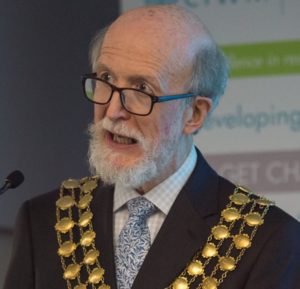
DCW gives his final speech as CIWM President
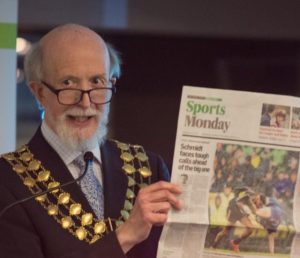
The Gaelic Football team which Enda Kiernan manages appeared in the lead photo story of the previous day’s Irish Times
Professor David C Wilson handed over the Presidency of CIWM, the UK and Irish professional body for resources and waste, to Enda Kiernan at the Aviva Stadium in Dublin on 13 November 2018. He highlighted plastics – both plastics entering the oceans and China’s ban on imports for recycling – as the dominant topic in his Presidential year. The public focus on marine plastics also helped dissemination of his Presidential report, the CIWM-Wasteaid Toolkit Making Waste Work; the website clocked 56,000 visits in its first year, with 7,000 downloads. DCW introduced his fellow Irishman, Enda Kiernan of Cork County Council as the next President. CIWM waited more than a century for its first Irish President; now we have had three in five years, and two in a row, although Enda is the first from the Republic of Ireland.
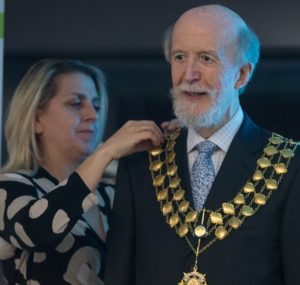
The chain of office is removed from DCW to pass over to Enda Kiernan
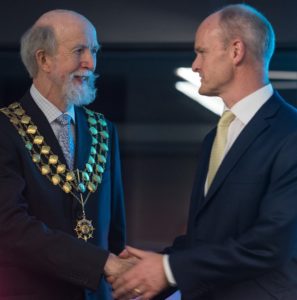
DCW congratulates Enda Kiernan on becoming the 103rd President of CIWM
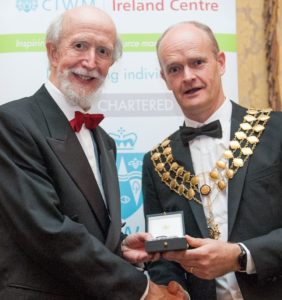
Enda Kiernan presents DCW with his Past President’s medal
31 October, 2018 | Conference, Resource and waste management
In his October column for the CIWM Journal, Professor David C Wilson reflects on the dominant story of his CIWM Presidential year, how we respond to the crisis of plastics entering our oceans. Which plastic uses are diabolic and should be banned, and which do we really need? One of his starting points was a recent CIWM-sponsored report which proposed a five-fold use-based categorisation of plastics. The other was the July Klosters Forum, which gathered 60 stakeholders from around the World to brainstorm on how to stem the flow of plastics into the oceans.
DCW proposes a three-way classification. At one extreme are the unacceptable, pointless, and often very short term (or ‘diabolic’) uses, which should be banned. At the other extreme are necessary or sustainable (‘fantastic’) uses, such as infection control, light-weighting cars and aircraft, and reducing food waste. In between is the largest category, which he labels as ‘indeterminate’. This can be further broken down into problem plastics, and replaceable plastics, which should both be phased out; and hard to replace plastics, where the focus should be on redesign and consolidation into a smaller number of truly ‘easy to recycle’ plastics used for ‘higher environmental value’ applications, such as preventing food waste.
14 October, 2018 | Publication, Resource and waste management
According to the UNEP and ISWA’s Global Waste Management Outlook (GWMO), three billion people lack access to basic solid waste management (SWM) services; addressing this global waste crisis would not only vastly improve their lives but also halve the weight of plastics entering the oceans. Professor David C Wilson and Mike Webster of Wasteaid made the case earlier this year, in an open access editorial in the ISWA journal Waste Management & Research, for community waste management as a ‘bottom up’ approach, to run in parallel to traditional ‘top-down’ approaches led by donors and governments.
Community waste management aims to help local communities in the poorest countries, where the local authority often has no funds to provide a SWM service, to tackle the problem themselves through the resource value in the wastes. If, for example, food wastes or low-value plastics are kept separate, they can be turned into new, useful products. With simple tools and the right knowledge, people can become self-employed recycling entrepreneurs, providing a very valuable service for the health and wellbeing of their community, and the whole planet – as well as reducing poverty and creating sustainable livelihoods.
One of the gaps identified by the GWMO was for practical guidance on such low-cost ‘waste to wealth’ technologies which involve minimal capital investment and make products to sell in a local market. DCW’s CIWM Presidential Report aimed to plug that gap: Wasteaid prepared a Toolkit, including a dozen How-to-do-it Guides for simple technologies using organics and low-value plastics.
While preparing the Toolkit, we identified a parallel requirement, for the scientific underpinning of some of the technologies. This month sees the publication of a paper on optimising the technology for producing plastic bonded sand blocks, for use e.g. as paving slabs, from the low value LDPE film plastic, which is a major problem even in the least-developed countries. Our team at Imperial College London was led by Professor Chris Cheeseman, with the laboratory research carried out by Alexander Kumi-Larbi Jnr and Danladi Yunana. The technology was developed by another co-authors, Pierre Kamsouloum, a self-taught entrepreneur from the Cameroun.
30 September, 2018 | Resource and waste management
CIWM President and lifelong waste policy and planning consultant David C Wilson reflects in his September column for the CIWM Journal on the challenges of devising the right policies to charge households for solid waste management services. Of course, we already pay for our solid waste services, but that charge is usually hidden within a wider charge or tax, which in the UK is council tax. Across Europe, many local authorities have been experimenting over the last https://www.babyscanclinic.com/blog/order-generic-levitra/ 20 years with pay-as-you-throw (PAYT) systems, where the charge varies at least in part according to usage. The growing evidence base suggests that PAYT does work, in terms of reducing waste quantities and increasing recycling. But why should local authorities, and ultimately households, pay for all the costs of municipal solid waste management? Particularly in the context of Defra’s forthcoming Resources and Waste Strategy for England, DCW argues for real Extended Producer Responsibility (EPR), with teeth, that will move the full financial burden of collecting, recycling and disposing of packaging and other products in the municipal waste stream from local authorities to the producers and supply chain. If we cannot have PAYT, let us at least have PAYB (pay-as-you-buy).
31 July, 2018 | Publication, Resource and waste management
In his July column, CIWM President David C Wilson makes the case for more investment in resource and waste management as an ‘entry point’ to achieve significant climate mitigation. The sector already has a track record in developed countries, with methane mitigation from landfill since the 1970s, and both methane mitigation and recycling making a major contribution to meeting Kyoto Convention greenhouse gas (GHG) reduction targets between 1990 and 2010. But that early success also means that the IPCC’s 2010 assessment is that the ‘waste’ sector only contributes 3-5% to current GHG emissions. DCW argues that this is a gross underestimate which fails to consider: the current emissions from uncontrolled burning; historical reductions; contributions across the economy from recycling; and waste prevention (particularly food waste). The results suggest that better resource and waste management has the potential for reducing GHG emissions across the World economy by 15, 20 or 25% or even more. Such numbers may be guesstimates, but whatever number we choose to use, the message is still the same. Further investment in this sector, in both developing and developed countries, is a major political priority in order to meet our climate targets.
This article was subsequently re-published by the National Solid Waste Association of India (NSWAI) in their member journal Waste Monitor in July 2019.




